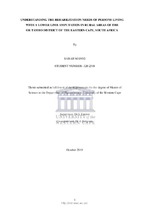| dc.description.abstract | Background: Globally, the leading cause of lower limb amputation is diabetes mellitus. In South Africa, there is a rise in diabetes-related lower limb amputation with a marked increase in the number of persons with diabetes mellitus in rural areas. However, there is no information on the number of people who are living with a lower limb amputation. An amputation does not only have an impact on a person’s physical functioning but can result in poor quality of life, dependence and exclusion from societal participation. Rehabilitation and prosthetic interventions are known to facilitate those with a lower limb amputation to return to independence in activities of daily living, improved quality of life and inclusion in society.
Access to health care is very challenging for persons living in rural areas. Challenges to accessing health care include limited rehabilitation staff, harsh terrain and far distances from services, a lack of access to transport, or the lack of confidence in the service provided by the healthcare institutions. For optimal and patient-centred outcomes, rehabilitation services are of paramount importance. Due to the challenges with providing services in rural areas, community-based rehabilitation is the ideal model for providing rehabilitation to persons with lower limb amputation in rural settings. In order to plan an appropriate community-based approach to rehabilitation, establishing the prevalence of disability and patient-specific needs are imperative.
Aims of the study: The aims of this study were firstly, to determine the period prevalence of people living with a lower limb amputation within the rural OR Tambo District of the Eastern Cape in order to determine the need for services and secondly, to gain a deeper understanding of the rehabilitation needs of persons living with a lower limb amputation within the rural OR Tambo District of the Eastern Cape. | en_US |

